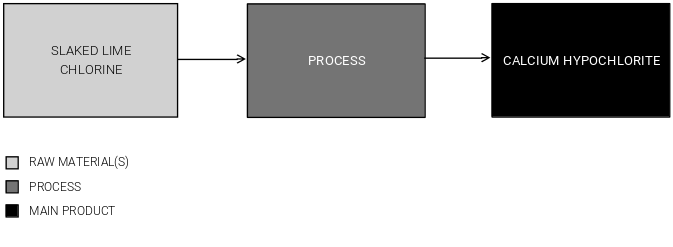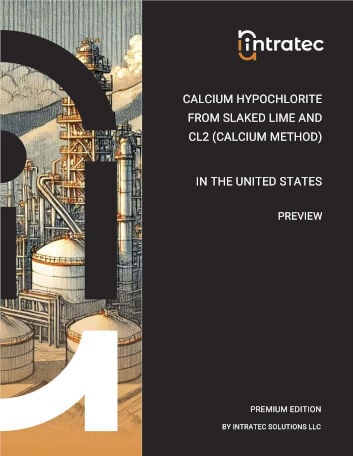Commodity Production Costs Report
Calcium Hypochlorite from Slaked Lime and Cl2 (Calcium Method)
Calcium Hypochlorite Plant Capital & Operating Cost Analysis | United States | Q3 2025
This report presents the economics of Calcium Hypochlorite production from slaked lime and chlorine. The process examined is a typical calcium process. This process consists mainly in the hydration and chlorination of slaked lime, generating a mixture of Calcium Hypochlorite, calcium chloride, and calcium hydroxide.
The report provides a comprehensive study of Calcium Hypochlorite production and related Calcium Hypochlorite production cost, covering three key aspects: a complete description of the Calcium Hypochlorite production process examined; an in-depth analysis of the related Calcium Hypochlorite plant capital cost (Capex); and an evaluation of the respective Calcium Hypochlorite plant operating costs (Opex).
The Calcium Hypochlorite production process description includes a block flow diagram (BFD), an overview of the industrial site installations, detailing both the process unit and the necessary infrastructure, process consumption figures and comprehensive process flow diagrams (PFD). The Calcium Hypochlorite plant capital cost analysis breaks down the Capex by plant cost (i.e., ISBL, OSBL and Contingency); owner's cost; working capital; and costs incurred during industrial plant commissioning and start-up. The Calcium Hypochlorite plant operating costs analysis covers operating expenses, including variable costs like raw materials and utilities, and fixed costs such as maintenance, labor, and depreciation.

Product
Calcium Hypochlorite. Calcium Hypochlorite is an inorganic salt with a white crystal solid appearance and a strong chlorine odor. It figures among the few metal hypochlorites that are stable enough to be produced as a solid salt, and it is the principal form of hypochlorite commercially produced worldwide. One of its characteristics is the far greater chlorine availability if compared to other chlorine salts, ranging from typical values of 60-99%.
Raw Materials
Chlorine. Chlorine figures among the most important chemical commodities. It is an indispensable intermediate in the chemical industry, employed in the manufacture of a multitude of end products (e.g. materials of construction, solvents, pesticides, etc). Most of chlorine produced on commercial scale is based on electrolysis of aqueous sodium chloride (brine), which also generates caustic soda and hydrogen as co-products (chlor-alkali processes).
Slaked Lime. Slaked lime is produced from limestone, a naturally occurring mineral consisting mainly of calcium carbonate. Limestone is thermally decomposed in quicklime (calcium oxide), which is then hydrated to slaked lime.
Report in PDF Format
Download & Explore Anytime
Access in Various Devices
Print & Read Comfortably
Share With Co-workers
Up-to-date Report
Professional report based on Q3 2025 economic data, ensuring timely evaluations.
Multiple Use Cases
Ideal for investment screening, feasibility studies, cost estimates, and research planning.
Proven Methodology
Developed using a consistent methodology honed over a decade, ensuring reliable cost analyses.
Report Editions
Content Highlights
Plant Capital Cost Summary
Summary outlining the capital cost required for building the Calcium Hypochlorite production plant examined.
Plant Capital Cost Details
Detailing of fixed capital (ISBL, OSBL & Owner’s Cost), working capital and additional capital requirements.
Plant Cost Breakdowns
Breakdown of Calcium Hypochlorite process unit (ISBL) costs and infrastructure (OSBL) costs; plant cost breakdown per discipline.
Operating Costs Summary
Summary presenting the operating variable costs and the total operating cost of the Calcium Hypochlorite production plant studied.
Operating Cost Details
Detailing of utilities costs, operating fixed costs and depreciation.
Plant Capacity Assessment
Comparative analysis of capital investment and operating costs for different Calcium Hypochlorite plant capacities.
Production Process Information
Block Flow Diagram, descriptions of process unit (ISBL) and site infrastructure (OSBL).
Process Consumptions
Raw materials and utilities consumption figures, by-products credits, labor requirements
Process Diagrams
Process flow diagrams (PFD), equipment list and industrial site configuration
Other Calcium Hypochlorite Production Cost Reports

Calcium Hypochlorite from Slaked Lime and Cl2 (Sodium Method)
This report presents the economics of Calcium Hypochlorite (70 wt%) production from slaked lime, sodium hydroxide and chlorine via a typical sodium process. In this process, chlorine is passed into a slurry of slaked lime and sodium hydroxide, generating calcium hypochlorite and sodium chloride. The economic analysis is based on a plant located in the United States.
Details: 25 kta United States-based plant | Q3 2025 | 107 pages | Issue A | From $799 USD
Bundle & Save
Purchase multiple Calcium Hypochlorite Production Cost reports and enjoy tiered discounts
up to 10% off!
Could Not Find the Report You Need?
Obtain a Bespoke Report
Get a report targeting the process in which you are interested
See Offer Details
Understand Bespoke Reports and how you can easily order them
Check Editions & Pricing
Complete a brief form and see a quotation for your Bespoke Report
Other Related Production Cost Reports

Chlorine Production from Sodium Chloride (Diaphragm Process)
This study presents the economics of Chlorine production from sodium chloride via a diaphragm plant located in the United States. In the process under analysis, an aqueous solution of sodium chloride (brine) is decomposed electrolytically in a diaphragm cell, producing Chlorine, sodium hydroxide and hydrogen.
Details: 550 kta United States-based plant | Q3 2025 | 107 pages | Issue B | From $799 USD

Chlorine Production from Sodium Chloride (Membrane Process)
This study presents the economics of Chlorine production from sodium chloride via a membrane process plant located in the United States. In the process under analysis, an aqueous solution of sodium chloride (brine) is decomposed electrolytically in a membrane cell, producing Chlorine, sodium hydroxide and hydrogen.
Details: 500 kta United States-based plant | Q3 2025 | 107 pages | Issue A | From $799 USD
+800 Reports Developed, Targeting +250 Commodities
Vast Report Library
858 independent and up-to-date reports examining embryonic and established production processes.
Free Sample Reports
Quickly understand the structure and depth of content of our professional reports.

